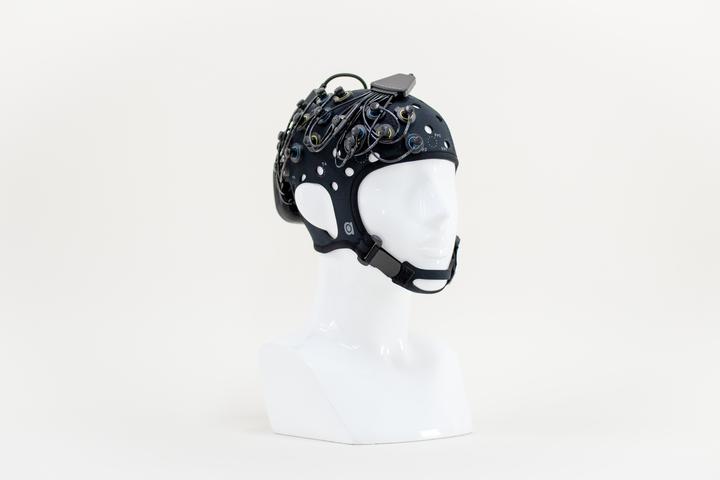Brite
A wearable & flexible multi-channel NIRS device for brain oxygenation measurement

Publications using the Brite
How Teacher-Related Factors Affect Students’ Higher-Order Thinking in the Urban Science Classroom: Evidence Based on Structural Equation Modeling and fNIRS
Teacher-related factors significantly impact students’ higher-order thinking. However, the mechanisms of how these factors specifically affect students’ higher-order thinking in urban science classrooms are unclear, especially in the absence of …
Effects of Internal and External Cues on Brain Activity and Gait in Parkinson’s Disease: Findings From BARC-PD
Background Internal and external cueing strategies are often applied to alleviate gait deficits in Parkinson’s disease (PD). However, it remains unclear which type of cueing strategy is most effective at different disease stages. The underlying …
A Performance Indicator for Optimizing Source–Detector Separation in Functional Near‐Infrared Spectroscopy
The performance of Functional Near‐Infrared Spectroscopy (fNIRS) devices critically depends on the probe design, which affects signal quality, spatial and depth resolution, and data reliability. A critical component of probe separation is …
Differences in sensory-motor cortex activation patterns during level and stair walking in patients with knee osteoarthritis: protocol for a cross-sectional study
Background Knee osteoarthritis (KOA) is a chronic degenerative disease characterized primarily by pain and joint dysfunction, especially during level and stair walking. Although traditionally classified as a peripheral joint disease, emerging …
Psychophysiological research in real-world environments: methodological perspectives from the SLU Multisensory Outdoor Laboratory
Growing evidence demonstrates the importance of environmental quality for human health and wellbeing. Environmental psychology can inform planning and design of future environments, but previous research often used simulated settings, limiting …
Resting-State Connectivity and Neuroimaging of Prefrontal Cortex Activity During a Block-Design Yoga Asana Practice Using fNIRS
This study aimed to use functional near-infrared spectroscopy (fNIRS) mobile neuroimaging technology to examine changes in prefrontal cortex (PFC) activity before, during, and after yoga asana (physical yoga postures). A total of 27 healthy adults …
Stress and Strategic Decision Making
Purpose Psychology and social science research offer some promising work in the field of decision-making science. However, given the qualitative nature of much of this research, understanding some physiological bases of decision-making may assist by …
Cerebral Haemodynamic Assessment Following Sport-related Concussion (Mild Traumatic Brain Injury) in Youth and Amateur Rugby Union Players
Background Using functional near-infrared spectroscopy (fNIRS) as an objective diagnostic tool, we aimed to (1) compare fNIRS measurements in adult and youth male rugby players against controls over a playing season, and 2) document the fNIRS changes …
Cortical functional connectivity and topology based on complex network graph theory analysis during acute pain stimuli
Purpose We aimed to investigate alterations in the topological organization of functional brain networks in acute pain. Methods A total of 29 capsaicin group (CAP) and 19 sham controls (Sham) underwent a 10-min resting-state functional near-infrared …
Development and Testing of Range of Motion Driven Motor Unit Recruitment Device for Knee Rehabilitation
Existing research on neuromuscular electrical stimulation (NMES) identifies two primary control approaches: therapist-operated systems and participant-controlled systems. Therapist-operated NMES devices typically employ switches and potentiometers …
Continuous Wave-Diffuse Optical Tomography (CW-DOT) in Human Brain Mapping: A Review
Continuous wave-diffuse optical tomography (CW-DOT) has emerged as a promising non-invasive neuroimaging technique for assessing brain function. Its ability to provide brain mapping with high spatial resolution over traditional functional …
Differences in brain function entropy due to cognitive impairment: Application of functional near infrared spectroscopy measures during dual-tasking
Screening guidelines for cognitive impairment are subjective and inconsistent, often leading to delayed diagnoses. An objective, simple method is needed. Dual-tasking, combined with brain function measurements, may provide sufficient cognitive cost …
Exploring Worker-Drone Interaction in Mixed Reality: Balancing Distraction and Situational Awareness
Mixed-reality (MR) technology has been widely used to simulate high-risk workplaces in order to minimize safety concerns. However, its use in understanding worker attentional allocation during interactions with drones in future construction …
Prefrontal Blood Flow Activity During Drawing Intervention in School-Age Children with Autism: An fNIRS Hyperscanning Study
Background/Objectives: Art-based interventions have been shown to enhance communication skills in children with autism spectrum disorder (ASD), yet their impact on prefrontal hemodynamics remains unclear. Methods: This study employed functional …
The application of fNIRS in studies on occupational workload: a systematic review
Background: Occupational workload can contribute to significant health problems such as chronic stress, fatigue and burnout. To investigate the underlying mechanisms, it is necessary to monitor brain activity in real work environments. Functional …
Yoga Asana Increases Pre-Frontal Cortex Activity and Reduces Resting State Functional Connectivity
Introduction: Various aspects of yoga have been researched for their psychological benefits, yet the neurological mechanisms underlying physical yoga postures (asana) remain inadequately explored due to limitations in prior neuroimaging techniques. …
Acute Cortical Brain Neuroexcitation Can Be Detected With Sacral Neuromodulation
Introduction Functional near infrared spectroscopy (fNIRS) is a noninvasive technique for measuring cortical brain neuroexcitation. Objective The objective of this study was to determine if fNIRS could detect differences in prefrontal cortex (PFC) …
Analytical pipeline optimisation in developmental fNIRS hyperscanning data: Neural coherence between 4- to 6-year old children collaborating with their mothers
Abstract Much of a child’s early learning takes place during social interactions with others. Neural synchrony, the temporal alignment of individuals’ functional brain activity, is a neural mechanism that may support successful interaction, but its …
Correlation Between Co-Design and Psychological Need Satisfaction Based on fNIRs Hyperscanning
With the increasing attention paid to user-oriented design and services, the term co-design, a form of user-participatory design, is increasingly mentioned. Previous studies have shown that co-design could better satisfy user needs in process and …
Detection of high-tone pelvic floor dysfunction using near infrared spectroscopy
High-tone pelvic floor dysfunction (HTPFD) is a neuromuscular disorder of the pelvic floor characterized by non-relaxing pelvic floor muscles, resulting in voiding and defecatory symptoms, sexual dysfunction, and pelvic pain. A challenge in the …